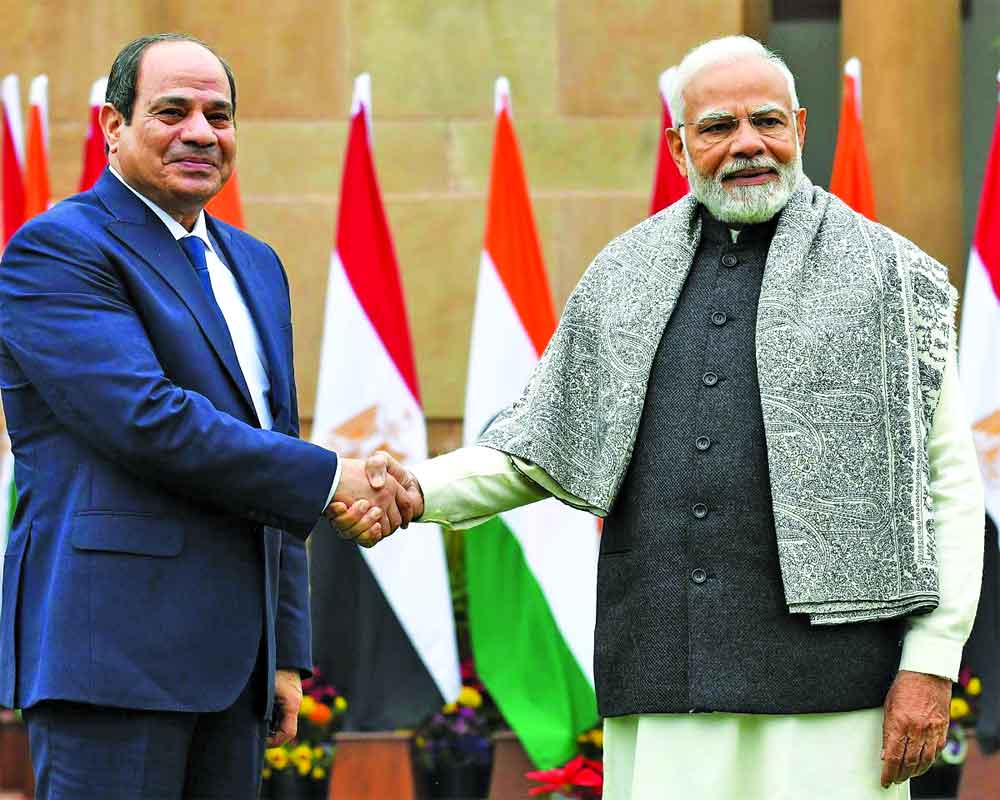Inviting President of Egypt as the chief guest at Republic day parade can usher in a new era in Indo Egyptian relations
President Abdel Fattah el-Sisi of Egypt made an interesting choice as the Chief Guest for the 74th Republic Day Parade, a first-ever from an Arab country. The choice is loaded with geopolitical and strategic suggestions that are rooted in realpolitik and better senses. As mutual people of civilizations and historical engagements, the bilateral relationship has gone through intermittent ups and downs borne of compulsions of internal political posturing and ‘bloc’ pressures.
Jawaharlal Nehru and Gamal Abdel Nasser along with Tito, Nkrumah, and Sukarno had jointly floated the Non-Aligned Movement towards, “abstention from the use of arrangements of collective defense to serve the particular interests of any of the big powers.” In the Indian context, shades of that thought exist in its modern course of ‘strategic independence’. However, considerations of co-religiosity had ensured that Egypt stood firmly on the side of Pakistan in the 1965 and 1971 wars, as also, Pakistanis had supplied military wherewithal to the Egyptians in1967 (Six-Day War) and 1973 (Yom Kippur War). As both were also Major Non-NATO allies, they had a ‘bloc’ gravitation.
Field Marshal Sisi (former General in the Egyptian Army) who had deposed a democratically elected government (Mohamed Morsi of the Muslim Brotherhood), presided over India’s celebration of adopting its Constitution that coup-proofed the Indian narrative with civilian control over the military, was irony at its best. Sisi has supposedly ‘won’ 97% of popular votes cast after ‘technicalities’ had disallowed almost all opposition (after imprisoning 40,000 from the opposition). Sisi is an authoritarian from the old school of Hosni Mubarak (also Air Chief Marshal of the Egyptian Air Force) governance style, only more strident. Serendipitously, on Indian Republic Day he witnessed the real and the largest democracy in the world, at the march.
Wounded memories of Military parades must have crossed Abdel Sisi’s mind on 26th Jan in Delhi, as a young Captain in 1981, Sisi’s Egypt was rocked by the assassination of President Anwar Sadat (also a former Soldier), also during a Military Parade. As part of marching contingents and weaponry display, an assassin party in one of the trucks towing an artillery piece had suddenly jumped out of formation and attacked the Presidential dais, fatally. Religious extremists from the radical Egyptian Islamic Jihad(also Egyptian Military personnel) were ostensibly upset with Anwar Sadat’s secular and pacifist moorings and had therefore undertaken the attack. In Delhi’s Republic Day parade, Sisi would have gathered a stark contrarian impression of a highly disciplined, apolitical, and constitutionalist Military.
Egypt was the fourth country to participate in India’s Republic Day celebrations with its marching contingent. Tellingly three of the four foreign contingents to have ever participated had been from Muslim-dominated countries i.e., UAE, Bangladesh, and Egypt(France was fourth). Interestingly, immediately behind the marching Egyptian contingent were the illustrious 61st Cavalrysowars in bay-colored horses, who have had their tryst with an Egyptian backdrop. Amalgamated from the various units of the Imperial Service State Forces of the former Indian Princely States, the DNA of 61st Cavalry harbours lancers from former ‘States’ of Jodhpur, Mysore, Patiala, etc., who took part in the last and most daringly successful cavalry charges in modern military history, at Haifa on 23rd September 1918. A German-led Ottoman expeditionary force was marching toward Egypt to seize the Suez Canal and was pitted against Egyptian Expeditionary Force and the township of Haifa was critical to defeating the Ottoman forces. 15th (Imperial Service) Cavalry Brigade composed of ‘State’ regiments from Princely ‘States’ of Jodhpur, Mysore, and Hyderabad was invoked for the near-impossible task against Ottoman forces with machine guns, etc..
Under the dashing Major Dalpat Singh Shekhawat of Jodhpur Lancers, Indian lancers had shocked the Ottomans with their fearlessness, daredevilry, and complete rout of Ottomans. 1350 German and Ottoman prisoners were taken, and eight Indian lives were lost (including Major Dalpat Singh, who was decorated with Military Cross, posthumously). The Egyptian Expeditionary Forces were greatly relieved and the Battle of Haifa became a turning point, thanks to the bravado of Indian Cavalry elements.
Times and circumstances have come a full circle and common threats beset both the ancient lands, albeit, with different governance structures. Abdel Sisi signed agreements with India to“strengthen defence cooperation” and “increase the exchange of counter-terrorism information and intelligence”. For a nation that supported Pakistan in its wars with India, Cairo now explores procuring India’s Tejas Light Combat Aircraft, Akash missile system, and DRDO’s Smart Anti-Airfield Weapon (SAAW). This is a significant shift considering a bulk of Egyptian military hardware is also from China e.g., bombers, fighters, missile system, ships, submarines, drones, etc., Whereas India’s nemesis across the Line-of-Control (LOC) still harps on the rote and tiring record of co-religiosity, which is sounding trite and troublesome, even with Arab Sheikhdoms and for autocrats like Abdel Sisi who seek to protect themselves against religious puritanism e.g., Muslim Brotherhood in Egypt. An indo-Egyptian framework is poised for a transformational reset.
(The writer, a military veteran, is a former Lt Governor of Andaman & Nicobar Islands and Puducherry. The views expressed are personal)

























